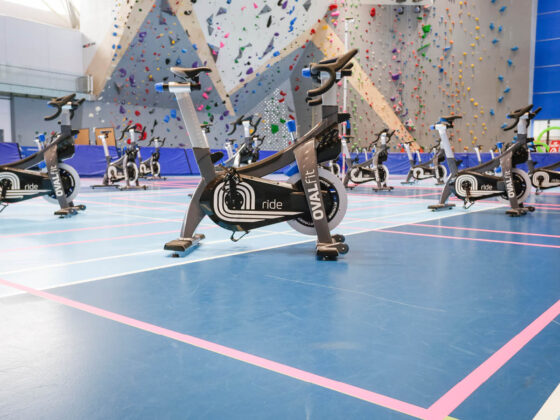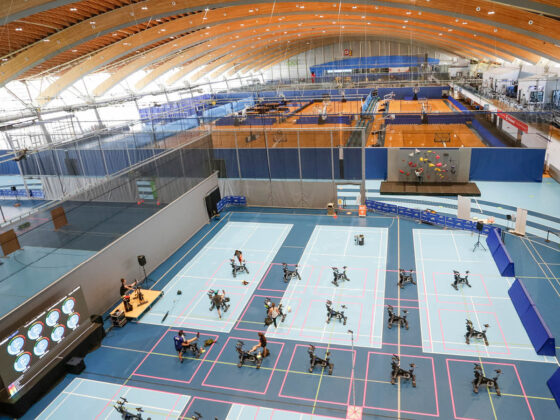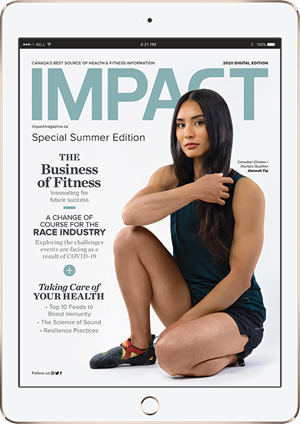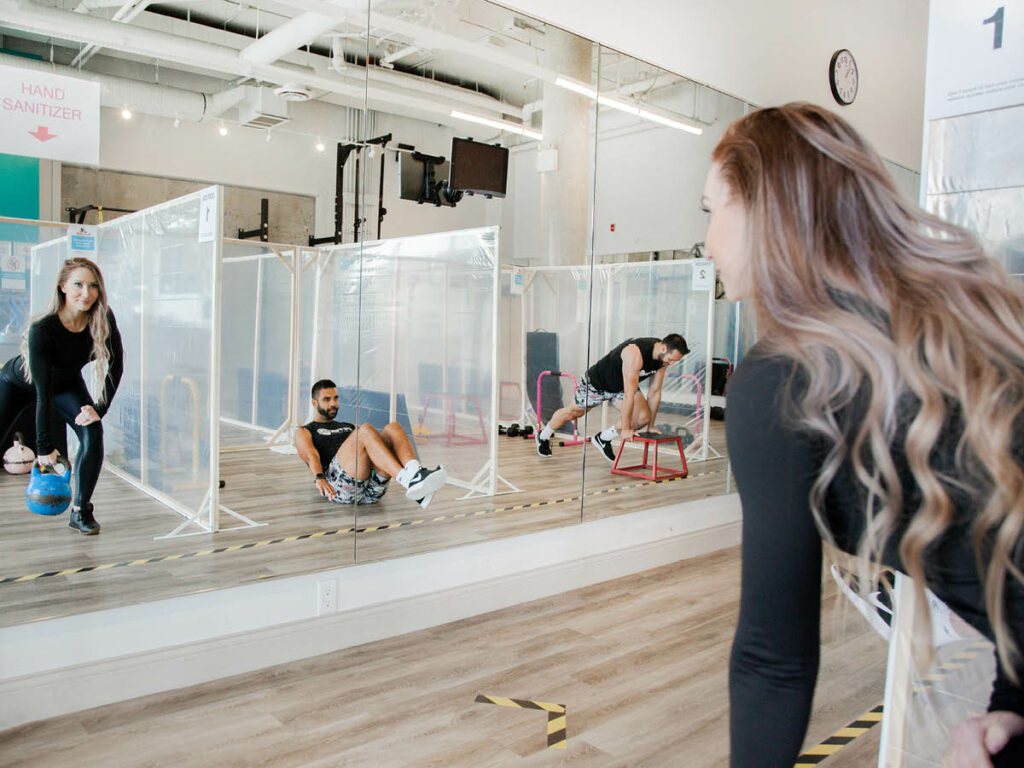
Resiliency, adaptability and innovation. These three words have come to describe the Canadian fitness industry as facilities came to grips with the COVID-19 lockdown in March and faced a harsh new reality. As gyms, fitness studios and recreation centres closed their doors, owners were forced to either adapt by providing a new model of service or close their doors indefinitely.
Fitness Facing A Critical Blow
The challenges facing the industry were widespread. Financially, everyone was affected once the doors were locked. A fitness community that had been thriving, was now in limbo and unable to provide services to clients who depended on them for physical health, mental health and overall wellness.
“In a matter of days, the personal training business that took me nearly 31 years to build was dealt a critical blow,” says Sandra Bueckert, owner of One On One Personal Fitness in Calgary. “Like many small business gym owners, I saw myself careening over a financial precipice.”
She wasn’t alone. From large recreation centres to boutique fitness studios, the fitness industry was one of the hardest hit by the COVID-19 pandemic.
“The months of April and May have historically been our highest revenue months and typically help compensate for the slower summer months,” said Sherry King, Executive Director at the Genesis Centre, a large, non-profit recreation facility in Calgary. “So receiving zero operational revenue during this time was severely detrimental.”
Some facilities like Calgary’s Glencoe Club and Repsol Sport Centre were already in a good financial position and although they suffered along with everyone else during the lockdown, it didn’t impact their ability to survive long-term. However, that didn’t mean they took the pandemic lying down.
Gyms Are Making The Best Of A Bad Situation
At Repsol Sports Centre, CEO Jeff Booke says they did what they could to reduce costs while the fitness facility was closed.
“We looked at everything from $10 to $1,000 items,” he explained. “We kept a skeleton staff using the Canada Emergency Wage Subsidy program (CEWS), reduced our utility consumption and cleaning costs and decreased the air handling turnover. Vending machines were unplugged, the pool temperature was decreased and we got rid of cable TV.”
Other smaller gyms and fitness studios, such as Fit in 30 Minutes in Vancouver and Success Fitness in Toronto, say they consider themselves lucky to still have been able to operate despite revenue drops of between 30 to 50 per cent.
The Hardest Thing For The Fitness Industry
One of the most difficult decisions gym owners faced was having to lay off staff.
“It hit us hard, there’s no sugar-coating it,” says Rafal Matuszewski of Ora Fitness and Yoga in Vancouver. “We had to let go of a lot of great people, and the handful of us responsible for the business took it upon ourselves to keep it alive.”
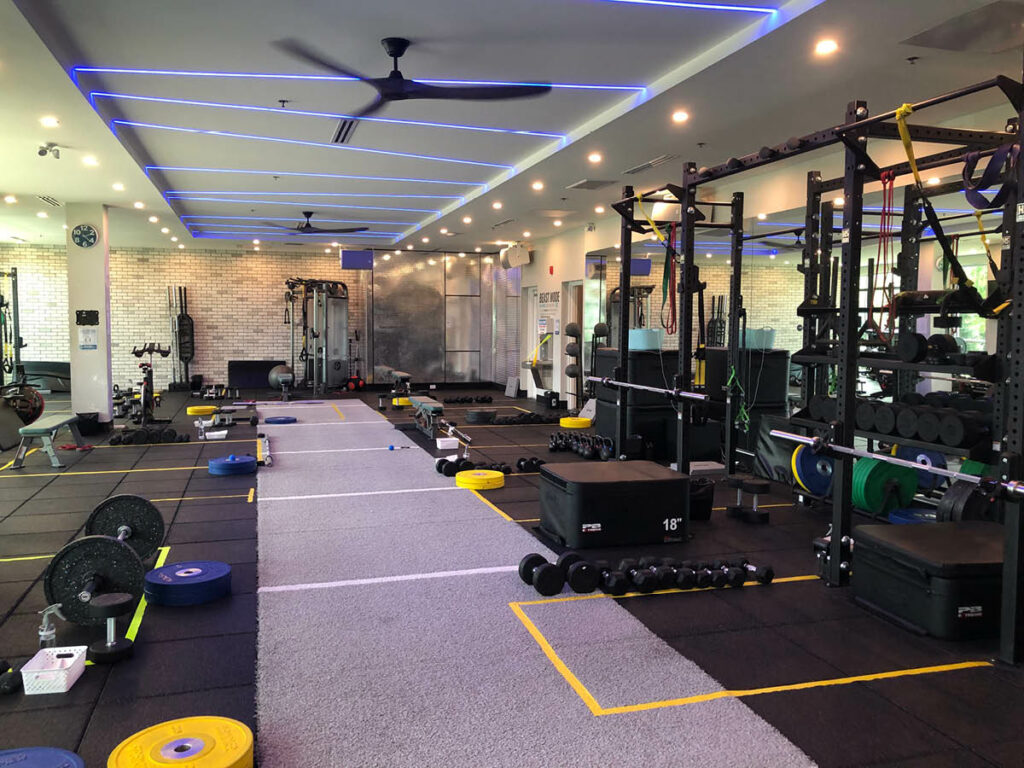
“Being mindful of our staff’s mental well being was of critical importance, and a need that took prominence,” says King of Genesis Centre.
Many businesses worked diligently with their staff to access government grant programs such as the Canada Emergency Response Benefit (CERB) and Employment Insurance (EI). Others asked their employees to take on the new role of virtual coach in order to keep working.
Virtual Transformation & Pivot
With their traditional revenue streams inaccessible due to the shut down, the entire fitness industry began switching to online instruction and many offered equipment loans to enhance the experience. While some facilities like Vancouver’s Fit in 30 Minutes were already offering online classes and were able to increase their programming seamlessly, others needed buy-in from trainers and gym staff to take on this new role.
“We started planning right away after the closure,” shares Vancouver’s Curtis Christopherson, President and CEO of Innovative Fitness. “We could close our doors and hope everyone came back, or pivot. We didn’t want the business to end after years of building it up, developing a fitness community and supporting clients. So we asked ‘Can we offer the same level of service in a different way? Would people value it? Would they see it as ‘not as good’ as in-person training?’
After a week of staff training, Innovative Fitness began offering virtual classes with 45 per cent of clients taking advantage. Over the first eight weeks of the lockdown, the company worked with 10,000 clients remotely.
Some of the smaller gyms were able to move more quickly into offering virtual classes and training to clients. Julia Bayne of Success Fitness (formerly Crossfit 6S) in Toronto, says within 48 hours they were online and had switched from group classes to one-on-one training.
“We were challenged by the fact that most of our clients live in small condos in the downtown area,” says Bayne. “They may have only had room to do a burpee. That’s where our one-on-one coaching excelled. The trainers were able to customize the workout to fit the client.”
Go Time For Online At Home Workouts
The switch to online fitness was practically universal across the industry. As the weather warmed up across the country, some facilities such as Repsol Sports Centre offered outside classes with lots of social distancing, which were so popular they sold out. But most gyms stuck with virtual.
At Ora Fitness and Yoga, Matuszewski says they started revamping their entire business to go online immediately.
“The very next day after we closed it was go time,” Matuszewski says. “We started filming non-stop, recording workouts for members to do at home for the next several days. We also started testing different software for online live workouts to keep our members going. We ended up creating something called ORA Online, which gave access to recorded workouts and was updated weekly. Personally, I have never worked so many 16-hour days in my life. I was living on large amounts of coffee!”
“Switching to virtual has really kept me on my toes, which was very therapeutic,” says Brent Bishop, owner of Think Fitness in Toronto. “We had offered virtual before, but not to this extent,” he laughs. “People’s eyes have been opened to virtual training and the benefits it offers. You can even take your trainer on vacation!”
Bishop initially built up his Instagram following by holding live Instagram workouts outdoors in his neighbourhood. He used a loud speaker as he conducted the session and soon people were exercising on their balconies along with him. He went from 50 to 200 to 1,200 people watching and working out together.
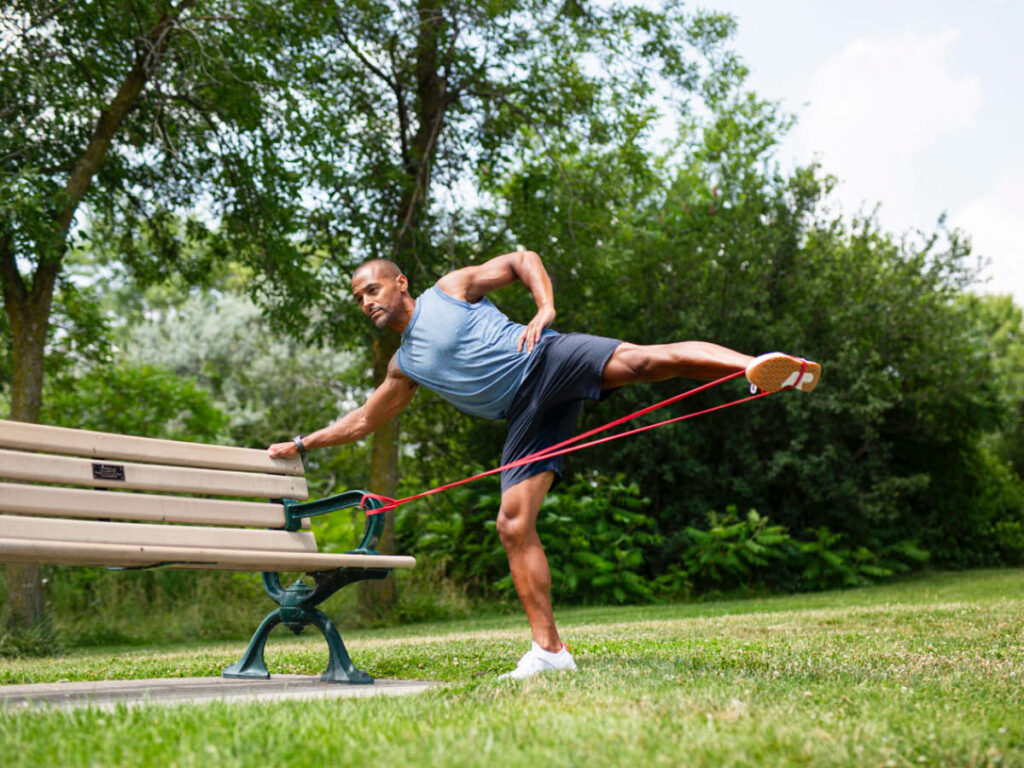
“This is a great time to launch anything virtual,” says Bishop. “There is a world-wide population open to it.”
He’s gone on to convert one of the studios in his gym into a professional film studio. It’s being used to broadcast live classes.
In Calgary, Bueckert says many of her clients were resistant to online training sessions and it took a lot of convincing at first. However, one by one they realized that their exercise sessions were needed and necessary for their physical and emotional health, and they agreed to try remote sessions. Since then Bueckert says the response has been overwhelmingly positive.
Creative Health & Fitness Solutions
Innovation across the industry was showing up in many ways. In Vancouver, Scott Salling of F.I.T. Academy decided to create a non-profit fitness platform called the F.I.T. Project.
“Our goal was to give to the community who were in need of some exercise and positivity,” Salling says. “What was a great surprise was that a few of our industry friends and IMPACT Magazine Canada’s Top Fitness Trainers came together to collaborate on the F.I.T. Project including Hannah Fletcher, Michelle Roots, Morgan Hodge, Liz Naccarato, Nikki Lefler and Zuzana Fajkusova to name a few.”
Bigger facilities went even further than fitness and personal training sessions, offering a huge range of virtual classes to members. The Glencoe Club included fitness options for children and teens, a Wellness Speaker Series, and online Bridge games and lessons. Once the weather improved, they added outdoor classes and even a birdwatching group. The Genesis Centre set up a lunch program and food hamper program for affected Calgarians and became a depot for the Calgary Interfaith Food Bank.
“We worked hard to stay connected to our community,” says Suzette O’Byrne, Recreation Director at the Glencoe Club. “There were many members who participated for the first time in the online classes and we connected to a whole new market and clientele.”
The generosity of spirit among fitness professionals really shone through during the dark days of the lockdown. All of them felt a duty of care to their clients and strove to find ways to meet their needs. Collaboration and consultation became de rigeur as people looked for the best ways to provide services and then to plan for eventual reopening.
Gyms Reopening Plans To Survive & Thrive
Nathan Amor had opened a new F45 gym in Calgary just eight days before the shut down in March. When he heard that fitness facilities were going to be in phase three of reopening the economy, he decided to take concrete action.
“As soon as they announced the relaunch I realized we’d need to fight this,” he said. “Gyms were scheduled for phase three along with arenas and sporting events. I’m one of those guys who doesn’t sit back when I see something I don’t like. I do something about it. Survive and thrive I say!”
He began speaking to other F45 gym owners in their online chat group and they began drafting letters to their MLAs and the Alberta Health Minister, Tyler Shandro.
“I started thinking about what drives politicians and the answer is voters!” Amor says. “So I created a petition to get gyms and boutique fitness studios in Alberta opened sooner than phase three, thinking maybe 100 or 200 people would sign it.”
His petition grew dramatically and in two days had 10,000 signatures, eventually reaching over 22,000.
“I don’t think our petition or lobbying efforts were the only reasons for gyms being moved to phase two of the reopening, but it helped!”
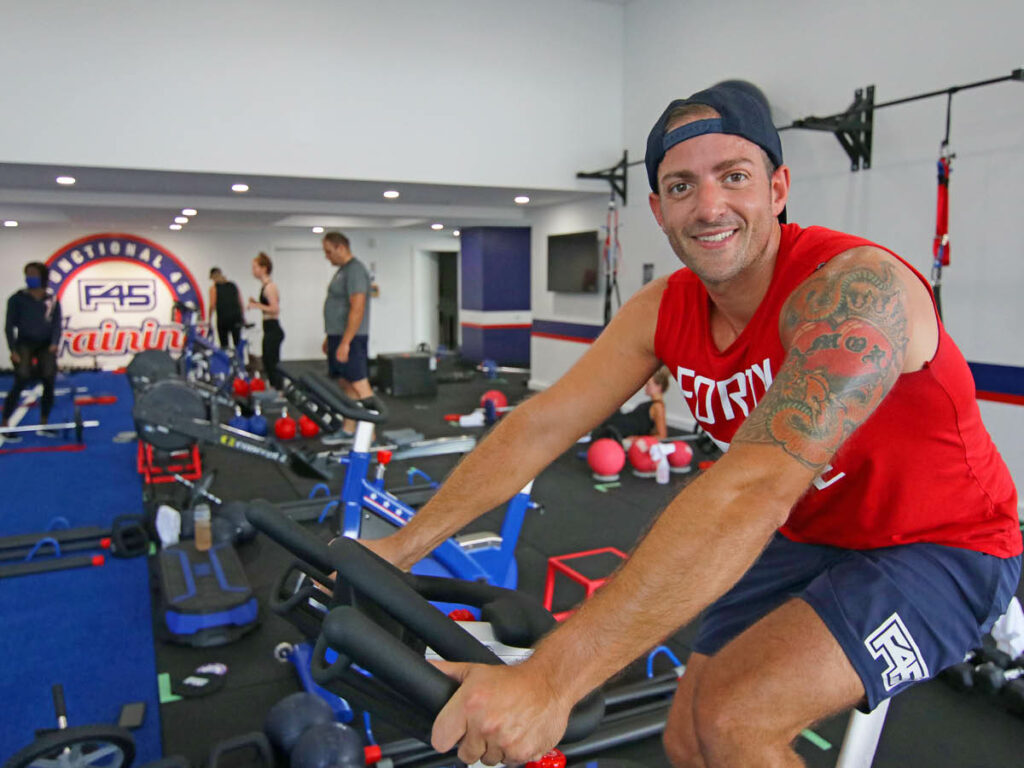
The New Norm For The Fitness Industry
Now that fitness centres across the country are slowly being allowed to reopen, in-person classes and training look quite different, having to take into account government-mandated safety protocols to reduce the transmission of COVID-19.
Many facilities have mapped out places for people to stand during classes to ensure social distancing is adequate. Others have set up ‘pods’ where clients can work out independently, having all the equipment they need close at hand. When they leave, everything is cleaned and readied for the next person. Drop-ins are a thing of the past – members and clients must book ahead to get a spot in pools, gyms, weight rooms or classes. And many facilities require masks.
Another big change is the cleaning required by fitness facilities to reduce the spread of the virus and meet government regulations. Many classes have been shortened to accommodate cleaning, and equipment is now wiped down after each client. Hand sanitizing and masks upon entry and exit is mandatory in most places and staff must wear masks.
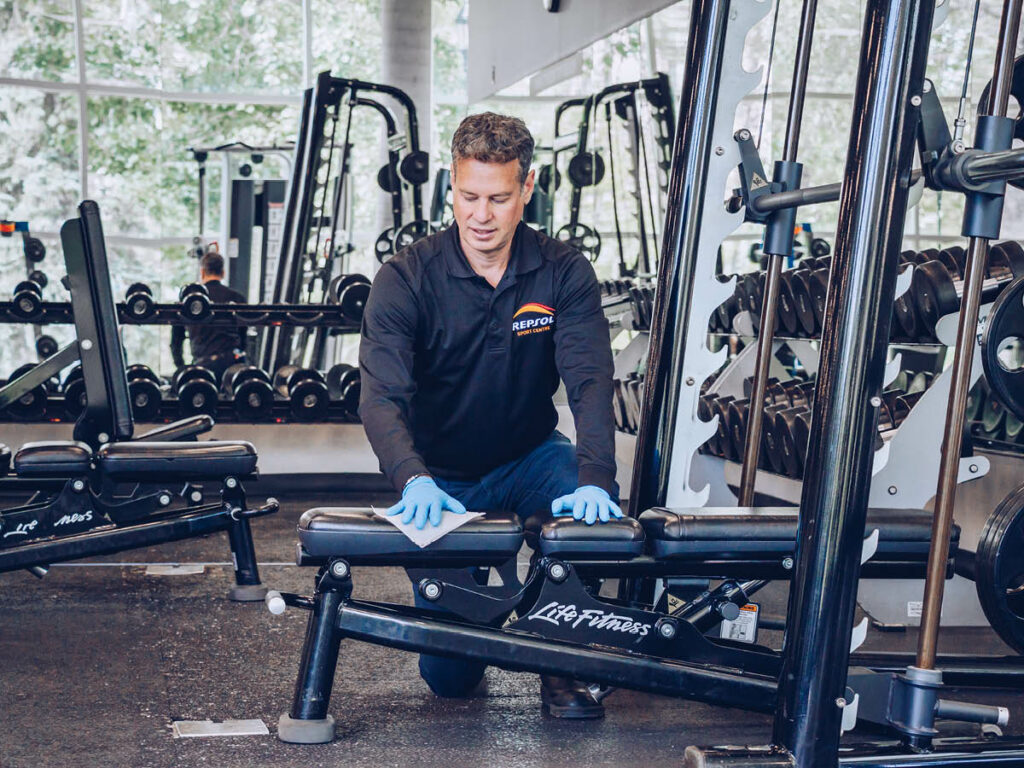
“GYMVMT members are encouraged to wear masks at the entrance and exit of our fitness clubs, especially where social distancing can’t be guaranteed. It’s most important for gym-goers to focus on hand hygiene, physical distancing and disinfecting equipment before and after use to help ensure a safe environment for themselves and others,” explains Scott Wildeman, SVP, Fitness and Operations, GYMVMT. The COVID-19 health guidelines provided by the Government of Alberta do not recommend wearing a mask during vigorous exercise, such as cardio, due to potential health risks.
Social Distancing & Workout Space Is Everything
One of the biggest challenges for the fitness industry is capacity and the ability to enable social distancing between clients. Large gym complexes like Repsol Sport Centre have room to expand their workout space and allow for greater social distancing between people.
“We took the gym closest to the free weights area and made it into a weight room complete with cardio equipment,” explains Repsol Sport Centre CEO Jeff Booke.
“From the outset, we took a very cautious approach to reopening, seeking guidance from the health authority and the City of Richmond,” explains Gerry De Cicco, General Manager, Oval Experiences & Venue Operations at the Richmond Olympic Oval. “For example, we moved our OVALRide cycling classes from a 1,500 square foot-studio and positioned the spin bikes over a 10,000 square foot space.”
“I realized that members were not afraid to return to the fitness studio environment itself, but that people have become nervous about being too close to one another,” says Andy Drakopolous of Legacy Indoor Cycling in Toronto. “Once I was clear on the fear, the solution came to me. I put blue and red tape on alternating bikes to allow us to host ‘blue’ or ‘red’ classes. The idea of alternating bikes gives the six feet of required separation and also ensures we don’t do back-to-back classes on the same spin bikes, despite them being cleaned after each ride. We also have everyone sign in with daily temperature checks and have closed our change rooms and suspended towel service for now. We are thrilled to be opened and will continue to follow extra safety measures as long as necessary.”
Smaller fitness facilities have more of a challenge. Numbers have to be reduced in order to meet social distancing requirements. Success Fitness says their classes will drop from 16 to 10 when they reopen in downtown Toronto. F45 in Calgary’s Inglewood district saw its class size drop from 36 to 15.
“I think one of the biggest impacts is going to be on fitness classes,” says Bishop. “How many classes do you need to offer to be profitable?”
“It’s hard to say how it will all work out but we’re looking at ways to maximize our space,” says Bayne. “After the first few weeks, we’ll re-evaluate and see where we can improve the experience for our clients.”
Matuszewski agrees capacity is their biggest challenge since reopening in Vancouver. Classes have gone from 20 to 12 spots in the gym, 26 to 12 in the spin studio and 26 to 9 in their yoga studio.
“Even with classes starting as early as 5:30 a.m. and going until 8 p.m. at night, we still have waitlists,” he said. “The simple solution is to add more classes to the day but we also need to be sure we can afford to pay our staff to do an extra class or two.”
Where Do We Go From Here With COVID-19?
Going forward, the future is uncertain given the ongoing COVID-19 pandemic and the potential for a second wave of infections later this year. The fitness industry will have to be nimble, changing quickly to adapt to a new norm.
Since the reopening of gyms in British Columbia, Alberta and Ontario, owners and employees say there has been a slow return of gym-goers.
“We reopened on June 1 and between 45 – 50 per cent of people came back to the gym right away,” says Christopherson of Innovative Fitness. “About 26 per cent wanted to a do a mix of coming to the gym and online training and 24 per cent weren’t ready for the gym at all.”
“The pandemic has changed the industry in EVERY way,” says Carl Macdonald of CityFit in Calgary. “The truth is that business models, pre-COVID-19 are now obsolete.”
While others in the industry aren’t as pessimistic, there is general agreement about the need for a new model of providing services. Many spoke of a ‘hybrid’ system where clients would only visit the gym periodically and complete the rest of their training with online resources.
“I think people will always value the human interaction aspect of personal training,” says Hannah Fletcher of Fit in 30 Minutes in Vancouver. “I believe many of them will do a hybrid of in-person training and online training. For example, our clients will meet their trainer or coach in person two to three times a week and then do online workouts and classes between their sessions. Fitness is now more accessible than ever and they save travel time by working out at home.”
“I think the days of being able to drop in may become a thing of the past,” says says De Cicco. “And while online registration is commonplace for boutique facilities and group fitness classes, there are several benefits of pre-booking your spot to work out, climb, play table tennis or shoot hoops. For one thing, it allows us to track who is in the building at any given time and know where they trained or played. Managing capacity will be the new norm.”
No Going Back For The Business Of Fitness
“As much as we want things to return to normal as soon as possible, the reality is that likely won’t happen for a long time, if at all,” says Lindsey Merrithew, co-founder and CEO of Merrithew, a pilates equipment provider and trainer. “Many clients won’t feel comfortable returning to the studio until there’s a vaccine. That means we need to bring the studio to them, whether that’s through continuing to provide high quality virtual instruction or with products and equipment that align with their needs and exercise goals.”
Many fitness professionals and personal trainers believe there will be a sea change within the business with people shifting away from classes and relying more on personal training.
“People feel a certain comfort level with one-on-one training because they aren’t surrounded by others,” says Christopherson of Innovative Fitness.
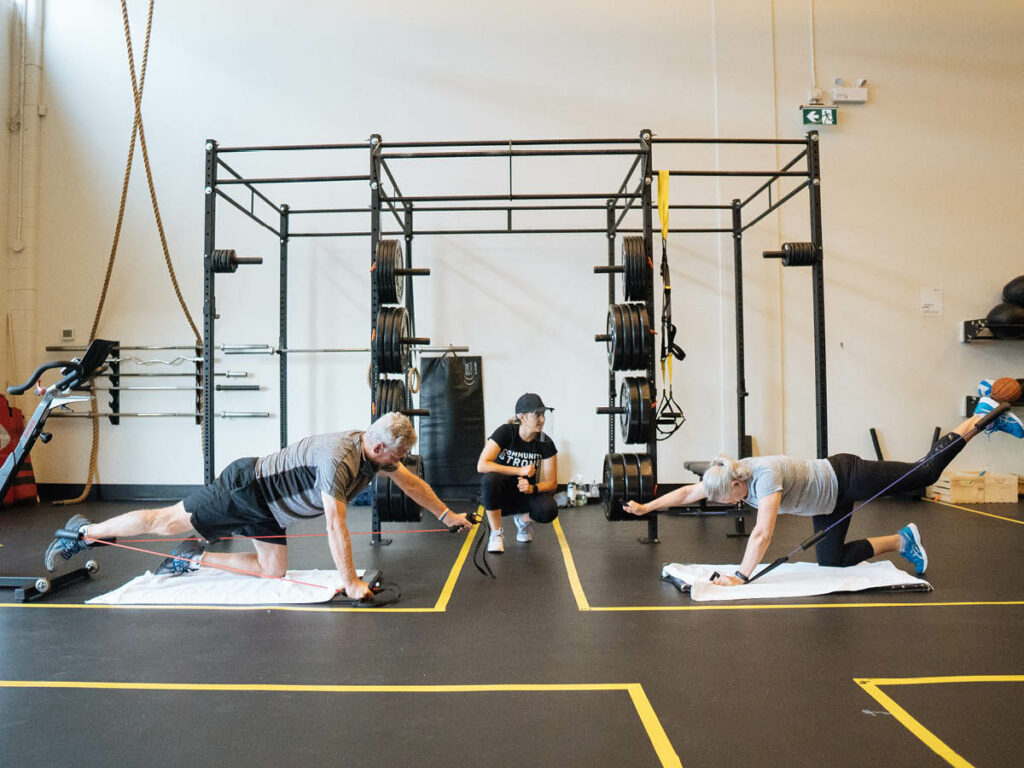
“I don’t think the fitness industry will ever be the same,” says Bayne. “ I think we’ll see more one-on-one training whether it’s at a gym, at home or outside. And I think the future is going to mean smaller classes. Large classes of 50 or 60 people may not be feasible anymore. We have to be sensitive to the space around people.”
If this trend solidifies, companies that rely on a business model built around group fitness classes will have to re-think their methods to manage the new expectations of clients and meet government requirements.
“Even with a vaccine, it is likely our customers will continue to expect a certain standard for cleanliness,” says De Cicco. “Operators may need to re-think how they space out their equipment and schedule services and programs. Away from training spaces, the industry may have to reassess how to design shower and locker room facilities, and even reconsider the use of hand dryers, hair dryers, fans or anything else that can spread particles.”
The Fitness Industry Future
It’s clear that online fitness instruction is here to stay. As Brent Bishop says: “We have a captive audience that we would never have had before COVID-19.” Moving toward a digital environment is seen by some as a natural progression within the fitness industry. And, as long as the programming and teaching standards are as high as they are in-person, the fitness industry can leverage the current boom in online classes and virtual training.
There could even be unexpected benefits with virtual fitness. As the Glencoe Club found out, offering online classes brought them in contact with a whole new audience that would never have attended in-person classes.
With so much uncertainty now it’s hard for many facilities to plan ahead and many questions are still unanswered. One thing is clear: people still want to stay fit and exercise. Home gym equipment has seen a 300 per cent increase in sales since the pandemic began and with the beginning of summer, outdoor spaces have been flooded with cyclists, runners and pedestrians.
“The economic impact on most Canadians will certainly affect consumer behaviour,” says Sherry King. “This is not to mention lingering psychological effects of people feeling unsafe to venture beyond their front doors. Will more people choose to do things online versus in-person, will more people invest in personal gym equipment and work out at home instead of coming to a facility such as the Genesis Centre? Only time will tell.”
Is There A Silver Lining To The Pandemic?
Despite the hardships caused by COVID-19, many among the fitness industry saw benefits that will linger long after it passes.
“I think a silver lining that has come from this situation is that many people have had time to reflect on their own needs and self-care, including fitness,” says Sherry King. “And as an extension, have realized how physical fitness aids one’s well-being in other ways too, like productivity and mental acuity.”
Some fitness professionals like Liz Naccarato, owner of NACC Fitness Personal Training, used downtime during the pandemic to self-educate and gain new skills. And many facilities, such as Repsol Sport Centre, used the closure to improve communication, refine practices and procedures, clean, repair and paint.
“COVID-19 has given us a unique opportunity to re-start and establish ourselves as leaders in our communities,” says Bayne. “At the end of this, we’ve learned a lot and our business will be much more robust as a result. We had to think creatively, try new things and be open to changes. As a business owner, I want to keep learning from other people and use this experience to be better.”
Most of the fitness community is optimistic about the future, even while not knowing what changes the pandemic may still bring. They have stepped up with their communities to support, guide and offer leadership. They care deeply about the health and wellness of their clients and members. And they’re willing to go the extra mile to make a difference.
“I believe it’s a great time to listen, learn and to come together for the greater good,” says Scott Salling of F.I.T. Academy. “What will the fitness industry look like in the future? I don’t know. All I know is, I can’t wait to be an integral part of the process and form more great relationships along the way.”
 IMPACT Magazine’s Special Summer Edition
IMPACT Magazine’s Special Summer Edition
This has not been a regular summer, and this is not a regular edition of IMPACT Magazine. In fact, it is an unprecedented issue that comes to you as a result of true grit and community support.

